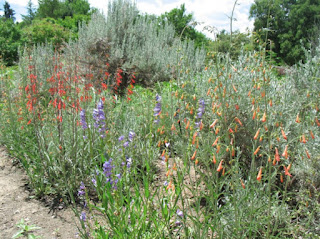Posted by: John Stolzle, Jefferson County Extension
Note: Many
vegetable gardens are in the midst of full production. If you find yourself with
an abundance of excess produce, I would encourage you to look into CSU Extension’s
Grow & Give program where you can learn helpful tips to grow produce and information about how you can share the harvest.
More information can be found on the Grow&Give program's website: http://growandgivecolorado.org/
This blog is not going to focus on vegetables, but instead present starter tips for planning a xeric or low water landscape. Across the state, summer heat is impacting our gardens and it has resulted in many common landscape plants struggling with heat and drought. Creatively designed and carefully planned landscapes which incorporate hardy xeric, or native plants can flourish under hot and droughty conditions.
 |
| Penstemon and sagebrush, Denver Botanic Gardens. Photo by Irene Shonle Provided in: CSU Factsheet for Low Water Native Plants - SE Colorado. |
The first step is to assess your landscape and begin selecting plants and to develop a general layout and plan. You’ll want to
consider the amount of sun that your landscape receives; southern and western exposures
particularly near buildings or pavement (with reflected heat) will often have the
greatest losses of water – to address this, consider using plants that are especially
tolerant of dry conditions. In exposed locations that are particularly steep
or difficult to irrigate such as terraced areas, you might consider planting a xeric
groundcover which can also help to prevent erosion. Once you have selected plants for your landscape, it can be
helpful to group them by water requirements.
A great
list of xeric groundcover plants to help get you started can be found at this following
link: https://extension.colostate.edu/docs/pubs/garden/07230.pdf
Additional resources to help start planning a xeric garden can be found towards the end of this blog post.
 |
| Heat reflected by the sides of buildings can be especially stressful for plants not well adapted to heat and drought. |
Step 2. Soil Prep and Irrigation Planning.
Once you have a plan in place for your landscape and plants picked out, you can help ensure the successful establishment of your plants by properly amending your soil when needed. If your soil is too sandy, nutrients and water can be lost to leaching below the root zone of your plants; if the soil is thick clay, a landscape can lose water to runoff. To cultivate a soil that is just right, you can add organic matter annually to garden areas to help improve moisture retention. Additional information regarding soil amendments can be found in this following link: https://extension.colostate.edu/docs/pubs/garden/07235.pdf
 |
| Drip irrigation isn't just for vegetable gardens, it can be very effective for other landscapes as well. |
Native and Xeric plants can withstand very trying conditions;
however, they are vulnerable and more sensitive when first becoming established. This process
can take up to three years after planting, and so it is important that newly
planted xeric and native plants are provided supplemental water during their
initial years in a landscape. If you have an irrigation system already installed,
you may wish to conduct an irrigation system self audit; if you do not have a
system installed, you may be interested in setting up a drip irrigation system.
Drip irrigation can be much more efficient than standard above ground sprinkler
systems.
Irrigation System Self Audit: https://extension.colostate.edu/topic-areas/yard-garden/lawn-irrigation-self-audit-lisa/
Drip Irrigation: https://extension.colostate.edu/docs/pubs/garden/04702.pdf
Step 3. Just add mulch.
Mulch can greatly help to conserve soil moisture, it can reduce soil temperatures, the amount of soil exposed to wind, and help manage weeds. Wood chips and pea gravel can make a great choice for trees, shrubs, or perennials; but stone mulch should be limited to less than half and inch in diameter for weed management and water conservation. Black rolled plastic, or woven ‘weed fabric’ can interfere with the flow of oxygen and water between the soil and air and this can sometimes harm plants. These types of mulch are not recommended for many landscape situations; however, they can be effective in vegetable gardens when used very carefully. You can find a reference link with more information on using fabric mulch in vegetable gardens, below.
If you are interested in learning more about xeriscaping or hardy drought tolerant plants, I would encourage you to look through the follow links for additional information on these topics.
 |
| A view of the Jeffco Plant Select garden. Plant select is a program run in partnership with Colorado State University and the Denver Botanic Gardens http://plantselect.org/plants/find-a-plant/ |
More information about Xeriscaping:
Retrofitting a Yard: https://extension.colostate.edu/docs/pubs/garden/07234.pdf
Low water native plant guides for all areas of Colorado: https://cmg.extension.colostate.edu/gardening-resources/online-garden-publications/native-plants/
More
detailed overview for creative xeriscaping: https://extension.colostate.edu/docs/pubs/garden/07228.pdf
Native
& Xeriscaping Plant Lists:
Perennials and Annuals: https://extension.colostate.edu/docs/pubs/garden/07231.pdf
Groundcover: https://extension.colostate.edu/docs/pubs/garden/07230.pdf
Trees & Shrubs: https://extension.colostate.edu/docs/pubs/garden/07229.pdf
Native Trees & Shrubs: https://extension.colostate.edu/docs/pubs/garden/07422.pdf
Native
Herbaceous Perennials: https://extension.colostate.edu/docs/pubs/garden/07242.pdf
Mulch:
Mulches for vegetable gardens (includes information on fabric mulch): https://cmg.extension.colostate.edu/Gardennotes/715.pdf
Mulches for home grounds: https://extension.colostate.edu/docs/pubs/garden/07214.pdf
Mulching trees: https://cmg.extension.colostate.edu/Gardennotes/658.pdf
Extra:
Fall and winter watering during drought:https://planttalk.colostate.edu/topics/trees-shrubs-vines/1751-fall-winter-watering-drought/
And as always, best of luck in your gardening endeavors!

No comments:
Post a Comment